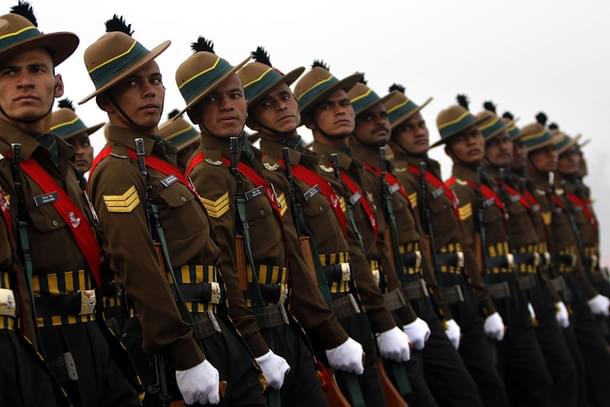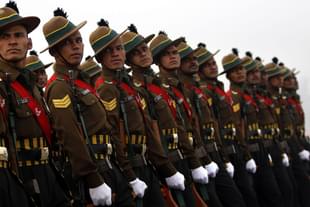Defence
Five Things Modi 3.0 Should Focus On For Indian Military
Ujjwal Shrotryia
Jun 07, 2024, 11:56 AM | Updated 11:56 AM IST
Save & read from anywhere!
Bookmark stories for easy access on any device or the Swarajya app.


The general elections are over, and the results are out.
With 293 seats, the Prime Minister Narendra Modi-led National Democratic Alliance (NDA) government is almost certain to come to power for the third straight term.
For the last 10 years, Indian armed forces have seen multiple tenuous phases.
From the tense phase in 2020 where Indian and Chinese troops clashed at Galwan Valley and Pangong Tso Lake in Ladakh to the subsequent four-year-long standoff, the 2016 surgical strikes inside the Line of Control (LoC) in Pakistan Occupied Kashmir (PoK), and the 2019 bombing strikes in Balakot inside Pakistan’s Khyber Pakhtunkhwa region, the Indian armed forces have seen dramatic changes.
It has seen an increase in its readiness from the early 2010s when it was reported that India did not have ammunition for 20 days of full-scale war, and for some equipment even a week.
The forces have seen the introduction of five positive indigenisation lists in the last five years, which have now begun to bear fruit, so much so that the Indian Army says it will not import any foreign ammunition from next year, barring some that are required in limited quantities.
It also saw the army ordering 118 made-in-India Arjun Mk-1A main battle tanks (MBT), the Indian Air Force ordering an additional 97 Tejas Mk-1A jets, and the government acquiescing to the Indian Navy’s demand to induct a third aircraft carrier, buying French Rafales for the navy and air force, and many more.
However, this is not enough.
There are many more reforms needed to transform the Indian armed forces into a force capable of fighting in this new era.
Here are those five things that the new government needs to take decisions on.
(1) Creation Of Integrated Theatre Commands
As the initial hours of the Russia-Ukraine war showed, it’s critical for the armed forces to plan and execute a large-scale operation jointly.
The Russian air force was nowhere to be found in the initial Russian push towards Kiev. There was no infantry support when columns of armour were racing towards Kiev along the highways of Ukraine.
Neither did they have artillery support.
After initial progress, the assault halted with significant casualties to Russian men and material, which has now ended up in a situation where, after two and a half years, the war has fizzled into fighting for small villages and towns — essentially a stalemate.
On the other hand, India’s primary adversary, China, already has integrated theatre commands, which they announced eight years ago in February 2016, while the armed forces top brass and government go round and round in endless discussions.
Just a month back, the Indian government instructed the armed forces to set up theatre commands within a year after the new government was sworn in.
It is the single largest reform in the armed forces since India’s independence. Planning and fighting jointly is critical for fighting in the wars of the 21st century.
Therefore, it is imperative that instead of discussions and possible delays, the new government take it head-on and push it through as fast as possible.
(2) Tweaks In Agniveer Policy
Since its introduction in 2022, the Agniveer policy has been under constant criticism and a source of disappointment for the youth.
Soon after it was introduced, there were widespread protests in UP and Bihar from youths who were disappointed with certain provisions of the scheme — primarily the percentage of Agniveers (25 per cent) that will be retained after the end of the four-year term — and the nine-month-long training time, which some retired officers say is not sufficient to make fully disciplined soldiers.
The scheme was primarily introduced to ease the burden of pensions on the defence budget, which has ballooned to levels where there are not enough funds left for modernisation and buying of new weapons.
As a Swarajya ground report pointed out (read here), even after two years of its introduction, there is still a sense of discontent with the voters (youth), which may also have an impact on BJP’s election tally.
BJP’s ally, Janata Dal (United) or (JDU), has also indicated that some tweaks may be necessary to address some of the scheme’s concerns.
Swarajya in its earlier report (read here) has also stated that no reform in its first avatar is perfect and that the Agniveer policy may also require tweaks in the future. And there are indications that this could be happening soon.
The Indian Army has started a survey from key stakeholders for recommendations for potential changes in the scheme. Rajnath Singh, the defence minister in PM Modi's last term, has also indicated that the government is open to changes in the scheme.
It’s now up to the new government to implement these changes urgently.
(3) Ink Pending Project For Big Ticket Items
There are multiple big-ticket projects that were stuck due to elections, the biggest of which was the transfer of technology (ToT) of the General Electric F414 jet engine for Tejas Mk-2 and the selection of the next generation high-thrust engine (110 KN) for AMCA Mk-2.
These two jet engine projects will define the future of Indian air power. Even a year’s delay in deciding on these will add further delays to the already late Tejas Mk-2 and AMCA programmes.
Deals for 97 new Tejas Mk-1A jets for the air force should also be inked, as should the 307 Advanced Towed Artillery Gun System (ATAGS) 155mm artillery guns and K-9 Vajra-T 155mm self-propelled howitzers.
The $4 billion deal for MQ-9Bs Guardian drones for the three armed forces should also be signed. A negotiating team for this is already in India and holding talks, as is for the 26 Rafale-M for the navy, where another team from France is in India for price negotiations.
Both these projects need to be inked immediately.
For the Indian Navy, sanction for the third INS Vikrant-like aircraft carrier should be given so that the empty line at Cochin Shipyard Limited (CSL) starts working again and the expertise gained from manufacturing INS Vikrant is not lost.
Instead of the limited orders, large-scale contracts for Nag, Helina, man-portable anti-tank guided missiles (MPATGM), Rudram-1 anti-radiation missiles, light utility helicopters (LUH), and high-speed low drag (HSLD) should be signed.
Another is the rocket force, the creation of which was announced in 2023.
Knowing full well that the Chinese have an advantage over India in all short, medium, and long-range cruise and ballistic missile categories, 370 orders of short to medium range Pralay missiles are just not going to cut it.
Judging from the expenditure of cruise and ballistic missiles by the Russians, these orders of a few hundred Pralays should be increased to the scale of a few thousand. Nirbhay missiles and their variants should also be inducted in large numbers, as should Pinaka guided rockets for the regular army’s artillery regiments.
(4) Reforms In DRDO
The government last year formed a committee under ex-principal scientific advisor Professor K Vijay Raghavan to suggest reforms in the Defence Research and Development Organisation (DRDO).
The committee gave its report to the government last year itself. Now these much-delayed reforms have to be implemented hurriedly.
Fortunately, the government just a fortnight ago (22 May) started implementation of these reforms, casting aside all aspersions from within the DRDO, with a deadline for completion until 31 August.
However, just like the Agniveer policy, no first version of a reform is perfect. The new government should be open to further iterations and constructive criticism from well-wishers for further improvements in these reforms.
(5) National Security Strategy
Just as reforms for overhauling existing structures and buying new cutting-edge technology are critical for the forces, in the same way, a clearly written National Security Strategy (NSS) is as important, or maybe even more.
Most of the critical policies of the army, air force, and navy, their future plans, and acquisitions flow out from an overarching security policy that lists out details of what India wants to achieve in the next 10 to 15 years.
For instance, the budget and planning will look way different if India wants to only contend with China inside its borders in Ladakh and in the Indian Ocean Region (IOR) compared to taking the fight to the Chinese, in the South China Sea (SCS) close to the second island chains and in Tibet beyond the Karakoram ranges deep inside Depsang Plains.
To that regard, Chief of Defence Staff (CDS) General Anil Chauhan's remarks a week back (29 May) stating that “the absence of a written National Security Strategy (NSS) doesn’t mean that the country doesn’t have one” and his question “I don’t know why people insist on that” do not instil confidence.
This again shows army’s stubborn resistance to reforms.
It's time the new government takes the bull by the horns and drafts a national security strategy.
Staff Writer at Swarajya. Writes on Indian Military and Defence.





